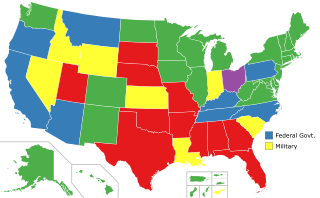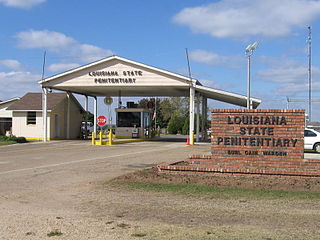Related Research Articles

The electric chair is a specialized device employed for carrying out capital punishment through the process of electrocution. During its use, the individual sentenced to death is securely strapped to a specially designed wooden chair and electrocuted via strategically positioned electrodes affixed to the head and leg. This method of execution was conceptualized by Alfred P. Southwick, a dentist based in Buffalo, New York, in 1881. Over the following decade, this execution technique was developed further, aiming to provide a more humane alternative to the conventional forms of execution, particularly hanging. The electric chair was first utilized in 1890 and subsequently became known as a symbol of this method of execution.

A gas chamber is an apparatus for killing humans or other animals with gas, consisting of a sealed chamber into which a poisonous or asphyxiant gas is introduced. Poisonous agents used include hydrogen cyanide and carbon monoxide.

In the United States, capital punishment is a legal penalty throughout the country at the federal level, in 27 states, and in American Samoa. It is also a legal penalty for some military offenses. Capital punishment has been abolished in 23 states and in the federal capital, Washington, D.C. It is usually applied for only the most serious crimes, such as aggravated murder. Although it is a legal penalty in 27 states, 19 states currently have the ability to execute death sentences, with the other 7, as well as the federal government and military, being subject to different types of moratoriums.

Capital punishment is a legal penalty in the U.S. state of Louisiana.

Capital punishment is a legal penalty in the U.S. state of Ohio, although all executions have been suspended indefinitely by Governor Mike DeWine until a replacement for lethal injection is chosen by the Ohio General Assembly. The last execution in the state was in July 2018, when Robert J. Van Hook was executed via lethal injection for murder.
Capital punishment is a legal penalty in the U.S. state of Oklahoma.
Inert gas asphyxiation is a form of asphyxiation which results from breathing a physiologically inert gas in the absence of oxygen, or a low amount of oxygen, rather than atmospheric air. Examples of physiologically inert gases, which have caused accidental or deliberate death by this mechanism, are argon, helium, nitrogen and methane. The term "physiologically inert" is used to indicate a gas which has no toxic or anesthetic properties and does not act upon the heart or hemoglobin. Instead, the gas acts as a simple diluent to reduce the oxygen concentration in inspired gas and blood to dangerously low levels, thereby eventually depriving cells in the body of oxygen.

Capital punishment in Alabama is a legal penalty. Alabama has the highest per capita capital sentencing rate in the United States. In some years, its courts impose more death sentences than Texas, a state that has a population five times as large. However, Texas has a higher rate of executions both in absolute terms and per capita.
Capital punishment is a legal penalty in the U.S. state of Arizona. After the execution of Joseph Wood in 2014, executions were temporarily suspended but resumed in 2022. On January 23, 2023, newly inaugurated governor Katie Hobbs ordered a review of death penalty protocols and in light of that, newly inaugurated attorney general Kris Mayes issued a hold on any executions in the state.
Bucklew v. Precythe, 587 U.S. ___ (2019), was a United States Supreme Court case regarding the standards for challenging methods of capital punishment under the Eighth Amendment to the United States Constitution. In a 5–4 decision, the Court held that when a convict sentenced to death challenges the State's method of execution due to claims of excessive pain, the convict must show that other alternative methods of execution exist and clearly demonstrate they would cause less pain than the state-determined one. The Court's opinion emphasized the precedential force of its prior decisions in Baze v. Rees and Glossip v. Gross.

Terry Melvin Sims was an American convicted murderer who was executed by the state of Florida for fatally shooting a sheriff's deputy in Longwood, Florida. He was the first Florida inmate executed with the use of lethal injection, after the previous execution, which was conducted under the electric chair, had been seriously botched.
Clarence Wayne Dixon was an American convicted murderer. He was convicted of the January 7, 1978, murder of 21-year-old Deana Lynne Bowdoin in Tempe, Arizona. The murder went unsolved until 2001, when DNA profiling linked him to the crime. Dixon, who was serving a life sentence for a 1986 sexual assault conviction, was found guilty of Bowdoin's murder and was formally sentenced to death on January 24, 2008. He was executed by lethal injection on May 11, 2022, in the state's first execution in nearly eight years, since the botched execution of Joseph Wood in 2014.
The execution of Joe Nathan James Jr. took place in the U.S. state of Alabama by means of lethal injection. James was sentenced to death for the 1994 murder of his ex-girlfriend, 26-year-old Faith Hall. His execution generated significant media attention and controversy due to a plea by the victim's family to spare his life and allegations that his execution would be botched.

The execution of Kenneth Eugene Smith took place in the U.S. state of Alabama by means of nitrogen hypoxia. It was the first execution in the world to use this particular method.
References
- ↑ "Alabama Inmates Currently on Death Row". Alabama Department of Corrections. Archived from the original on October 24, 2012. Retrieved June 8, 2024.
- 1 2 "Death sentence in Ala. workplace shootings". United Press International . June 18, 2000. Retrieved June 8, 2024.
- ↑ Sue Anne Pressley (August 6, 1999). "Gunman Kills 3 at 2 Firms". The Washington Post . Retrieved June 8, 2024.
- ↑ "Alabama gunman kills three". BBC News . August 5, 1999. Retrieved June 8, 2024.
- 1 2 3 "Alabama execution of man who killed 3 in workplace shooting called off for time and medical concerns". NBC News . September 23, 2022. Retrieved June 8, 2024.
- ↑ Mealins, Evan; Lyman, Brian (September 23, 2022). "Legal challenges, difficulty establishing an IV complicated hours before Miller's death warrant expired". Montgomery Advertiser . Retrieved June 8, 2024.
- 1 2 Kim, Chloe (February 22, 2024). "Second Alabama man to be executed by nitrogen gas". BBC News . Archived from the original on June 8, 2024. Retrieved June 8, 2024.
- ↑ Chandler, Kim (May 8, 2024). "Alabama schedules second execution by nitrogen gas". Associated Press . Retrieved June 8, 2024.
- ↑ Chapoco, Ralph (May 8, 2024). "Gov. Kay Ivey schedules nitrogen execution for Alan Eugene Miller". Alabama Reflector . Retrieved June 8, 2024.